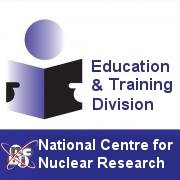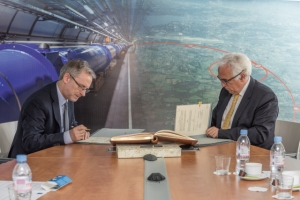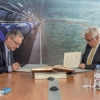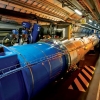CERN/NCBJ cooperation agreement extended
2016.04.22 11:30 - adminK.Kurek, NCBJ Director General (left), and Dr. Frédérick Bordry, CERN Director for Accelerator Technologies (right) (photo CERN)
On April 20, 2016 Professor Krzysztof Kurek, NCBJ Director General, and Dr. Frédérick Bordry, CERN Director for Accelerator Technologies, signed an agreement on future CERN/NCBJ cooperation. Particular emphasis was put on further R&D works aimed to improve performance of the Large Hadron Collider (LHC) accelerator.
The agreement has set a framework for further NCBJ/CERN cooperation. By virtue of the agreement Świerk scientists/technicians shall be engaged more actively not only in CERN scientific endeavours, but also in R&D works aimed to improve LHC performance.
“The just reached agreement would not be possible if the quality of works done by Polish scientists and technicians as our contribution to the development and operation of LHC during its first run has not been evaluated as high” – pointed out Professor Krzysztof Kurek, NCBJ Director General. – “Our partners has also highly appreciated our contribution to efforts to upgrade the facility, including delivery of some elements for the first accelerator in the chain of devices supplying LHC with beams of particles”.
The two year-long break in operation (2013-2015) was used to fix some key LHC elements and to improve its overall performance. Every orbit-controlling superconducting magnet has been tested, some of them have been replaced. A new cryogenic system supplying the magnets has been developed and constructed. A safer vacuum system, better solutions capable to focus particle beams and to boost particle energy, and better radiation-resistant electronic circuitry have been implemented. Since LHC is a very complicated machine, the works had to be conducted very accurately. Nothing strange that a number of high-class experts in various fields were involved, and the work were time-consuming. Polish groups actively participated in works of the experts.
After that thorough upgrading process, LHC was re-started in 2015. The most significant results of the upgrade include increase of particle energy to 6.5 TeV and increase of frequency of collisions. Researchers hope that during the LHC Run 2 scheduled till 2017 some more accurate information on Higgs boson, dark matter, super-symmetry, anti-matter, quark-gluon plasma, and/or exotic particles will become available.
Physicists assume that LHC will remain operational for another 20 years, including a few scheduled maintenance/upgrade breaks. Future plans will depend on scientific discoveries, and on organizational/technological/economic capabilities.
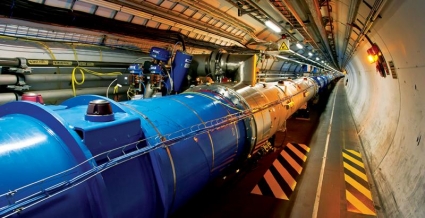
The Large Hadron Collider is the world's largest and most powerful particle accelerator (photo CERN)
LHC is the most complicated machine ever constructed by man. It is a kind of microscope that helps to investigate very small objects of the world. To that end two beams of proton/lead ions running in opposite directions with extremely high energies are brought to collision. In order that could happen, an entire chain of accelerators that gradually accelerate the particles to ever higher energies is needed. In case of protons all begins from gaseous hydrogen, atoms of which are composed of just one proton and one electron. Every few hours a portion of gas is taken from a small pressurized cylinder and hydrogen atoms are stripped of their electrons (ionized). The remaining protons are injected into a linear accelerator that accelerates them to a velocity of about 30% of light velocity. The next accelerator (PS Booster) increases proton energy almost 30 times. Each of the subsequent accelerators on the protons path (Proton Synchrotron PS, then Proton Super Synchrotron SPS) boost proton energy about 20 times. Finally the protons are injected into the LHC tunnel. Each day LHC consumes merely a few nanograms (10-9 g) of hydrogen. In other words 1 gram of gaseous hydrogen would suffice for about one million years of operation.
LHC forms the injected particles into two beams moving opposite directions. They travel along two parallel circular tubes in a tunnel of 27 km circumference about 100 m below the ground (the ring). Diameter of each of the tubes is a few centimetres. Ultra-high vacuum must be kept at all times inside both tubes or else the particles travelling inside would quickly scatter on gas molecules. Target velocity of protons accelerated in LHC is 0.999999991 of light velocity. At that velocity protons orbit the ring more than 11,000 times every second. Very high magnetic fields are necessary to bend trajectories of high-energy particles along the ring. The field is generated by more than 1,200 mighty dipole electromagnets, coils of which conduct electric currents on the order of several thousand Amperes (comparable to a small lightning). Such currents are impractical unless the magnets are in superconducting state, i.e. their coils exhibit no electrical resistance. To be in superconducting state, magnets must be cooled down to a very low temperature of just 1.9 Kelvin (degrees above absolute zero). It means that interior of LHC is colder than extra-terrestrial open space. Beside dipole magnets that route the particles along the tubes, LHC is also equipped with a number of beam focussing/geometry correcting magnets that prevent beam divergence and focus the beams in designated collision points.
Protons orbit the ring grouped in bunches (packets). There are about 100 billion particles in each bunch. More than 5,600 bunches mutually separated by about 7 metres may orbit simultaneously the ring. Energy of all orbiting bunches corresponds to explosion of 80 kg of TNT, or a train of 800 tonnes mass moving with velocity of 150 km/h. It is a quite challenging task to control so big energies inside so complicated facility.
Particles accelerated to their final energy may orbit the ring for many hours. However, their number is steadily decreasing because periodically beams are intentionally collided within ring sections encircled by detectors, as well as because some particles in the beams inevitable scatter on residue gas molecules within the entire accelerator tubes. After a few hours beams are diverted outside the ring and directed on some graphite blocks where they stop.
Kinetic energy of colliding primary particles (protons or lead nuclei) is converted into new, mostly unstable, particles. They are identified, their parameters (electric charge, velocity, mass, energy) are measured, and their tracks are reconstructed on the basis of various data logged by detectors. Really heavy particles live less than 1 picosecond (10-12 s), therefore they cannot be observed by any detection setup. They can be studied only indirectly by analysis of parameters of products of their decays.
Opposite beams are collided only in sections of the ring encircled by detectors developed by various teams of experimentalists (in physicists’ jargon: experiments or collaborations). The four main LHC detectors include ATLAS, CMS, ALICE and LHCb. 46 m long, 25 m wide, and 25 m tall ATLAS is the largest LHC detector. It weighs 7,000 tonnes. Its 8 superconducting magnetic coils, each 25 m long, form a cylinder around the accelerator tube routed through its centre. CMS is a bit smaller but almost twice as heavy. Total proton-proton collision rate in LHC may reach billions per second, much more that detector data logging capabilities. Besides, majority of the collisions produce only uninteresting events (from the researchers’ point of view). Therefore special electronic circuitry – called trigger – is needed in every experiment to select and log only interesting events. Triggers must be very fast to make decisions on-the-fly.


